Formation of Abnormal Gas-Geochemical Fields and Dissolved Gases Transport at the Shallow Northeastern Shelf of Sakhalin Island in Warm Season: Expedition Data and Remote Sensing
Abstract
1. Introduction

2. Materials and Methods
3. Oceanographic Features of the Research Area
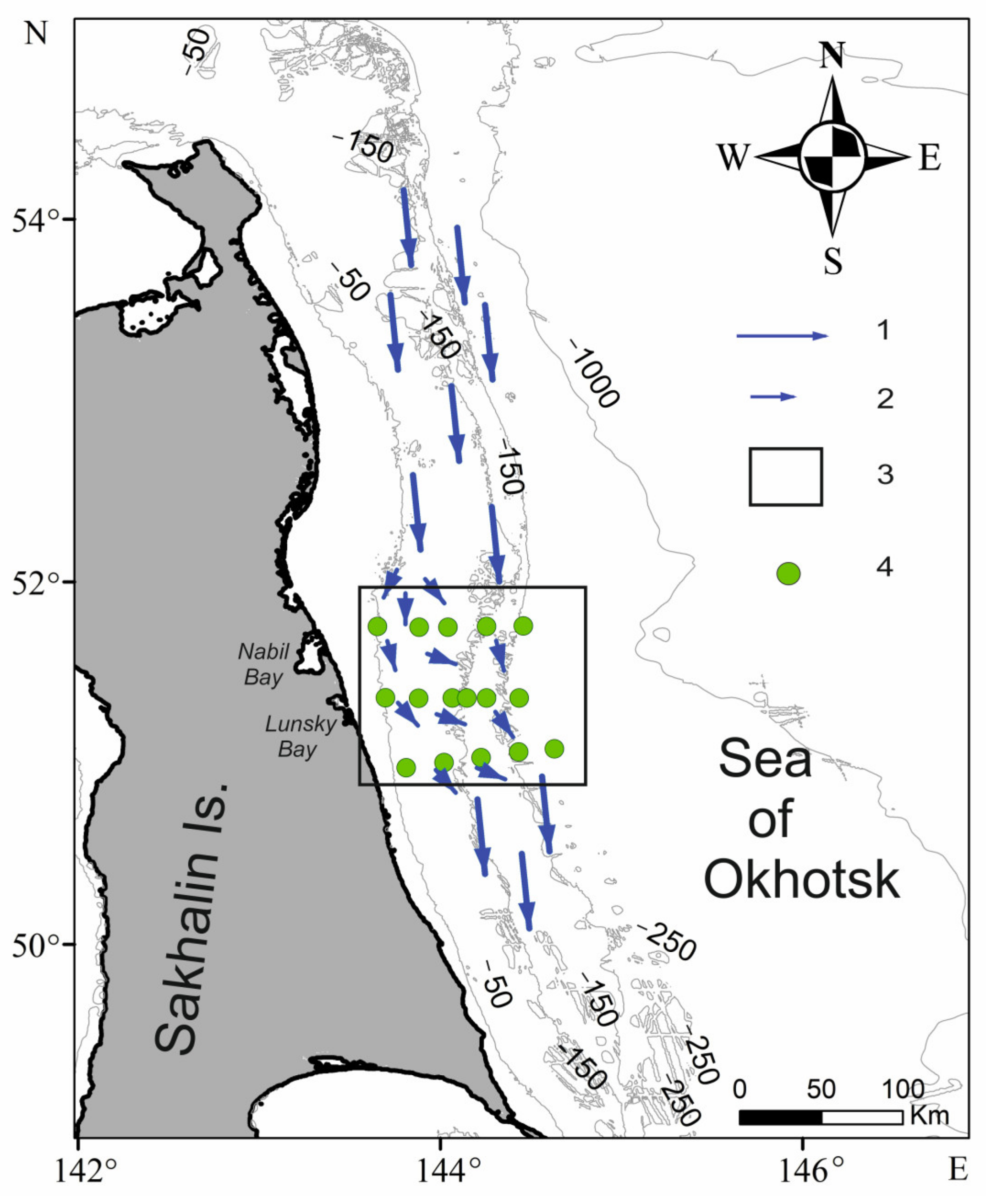
4. Geological Features of the Research Area
5. Results and Discussion
6. Conclusions
Author Contributions
Funding
Data Availability Statement
Acknowledgments
Conflicts of Interest
References
- Shakirov, R.B. Gasgeochemical Fields of the Eastern Asia Marginal Seas; GEOS: Moscow, Russia, 2018; 341p. [Google Scholar]
- Grannik, V.M. Comparison of structural elements of Sakhalin and Hokkaido. Dokl. Earth Sci. 2005, 401, 177–181. (In Russian) [Google Scholar]
- Grannik, V.M. The East-Sakhalin island arc system of the Okhotsk Sea region. Litosfera 2013, 1, 36–51. (In Russian) [Google Scholar]
- Rozhdestvenskiy, V.S. Evolution of the Sakhalin folds system. Tectonophysics 1986, 127, 331–339. [Google Scholar] [CrossRef]
- Khanchuk, A.I. The Geological Structure and Evolution of the Continental Surroundings of the NW Pacific Ocean. Ph.D. Thesis, Geological Institute of the Academy, Moscow, Russia, 1993; p. 31. [Google Scholar]
- Chekhovich, V.D. The Tectonics and Geodynamicsof the Folded Surroundings of Small Oceanic Basins; Nauka: Moscow, Russia, 1993; p. 272. [Google Scholar]
- Isozaki, Y. Anatomy and genesis of a subduction-related orogen: A new view on the geotectonic subdivision and evolution of the Japanese Islands. Isl. Arc 1996, 5, 289. [Google Scholar] [CrossRef]
- Maruyama, S.; Isozaki, Y.; Kimura, G.; Terabayashi, M. Paleogeographic maps of the Japanese Islands: Platetectonic synthesis from 750 Ma to the present. Isl. Arc 1997, 6, 121. [Google Scholar] [CrossRef]
- Zharov, A.E. South Sakhalin tectonics and geodynamics: A model for the Cretaceous-Paleogene accretion of the East Asian continental margin. Russ. J. Earth. Sci. 2005, 7, ES5002. [Google Scholar] [CrossRef][Green Version]
- Zlobin, T.K.; Bobkov, A.O. Modern Seismicity and Fault Tectonics of the South of Sakhalin; Publishing house of SAKHGU: Yuzhno-Sakhalinsk, Russia, 2003; 124p. (In Russian) [Google Scholar]
- Earthquake Hazards Program. Available online: https://earthquake.usgs.gov (accessed on 20 February 2024).
- Avdeiko, G.P.; Gavrilenko, G.M.; Chertkova, L.V.; Bondarenko, V.I.; Rashidov, V.A.; Guseva, V.I.; Maltseva, V.I.; Sazonov, V.I. and others. Underwater gas hydrothermal activity on the northwestern slope of Paramushir Island (Kuril Islands). Volcanol. Seismol. 1984, 6, 66–81. (In Russian) [Google Scholar]
- Ginsburg, G.D.; Soloviev, V.A.; Cranston, R.E.; Lorenson, T.D.; Kvenvolden, K.A. Gas hydrates from continental slope, offshore Sakhalin Island, Okhotsk Sea. Geo-Mar. Lett. 1993, 13, 41–48. [Google Scholar] [CrossRef]
- Obzhirov, A.I. Gasgeochemical manifestation of gashydrates in the Sea of Okhotsk. Alsk. Geol. 1992, 21, 1–7. [Google Scholar]
- Lammers, S.; Suess, E.; Mansurov, M.N.; Anikiev, V.V. Variations of atmospheric methane supply from the Sea of Okhotsk induced by seasonal ice cover. Glob. Biogeochem. Cycle 1995, 9, 351–358. [Google Scholar] [CrossRef]
- Heggland, R. Gas seepage is an indicator of deeper prospective reservoirs. A study based on exploration 3D seismic data. Mar. Pet. Geol. 1998, 15, 1–9. [Google Scholar] [CrossRef]
- Hagen, R.A.; Vogt, P.R. Seasonal variability of shallow biogenic gas in Chesapeake Bay. Mar. Geol. 1999, 158, 75–88. [Google Scholar] [CrossRef]
- Etiope, G.; Italiano, F.; Fuda, L.; Favali, P.; Frugoni, F.; Calcara, M.; Smriglio, G.; Gamberi, F.; Marani, M. Deep Submarine Gas Vents in the Aeolian Offshore. Phys. Chem. Earth Part B Hydrol. Ocean. Atmos. 2000, 25, 25–28. [Google Scholar] [CrossRef]
- Lorenson, T.D.; Kvenvolden, K.A.; Hostettler, F.D. Hydrocarbon geochemistry of cold seeps in the Monterey Bay. Mar. Geol. 2002, 181, 285–304. [Google Scholar] [CrossRef]
- Obzhirov, A.I.; Ilyichev, V.I.; Kulinich, R.G. Anomaly of natural gases in bottom water. DAN USSR 1985, 281, 1206–1209. (In Russian) [Google Scholar]
- Kulinich, R.G.; Obzhirov, A.I. Structure and modern activity of the joint zone of the Sunda shelf and the South China Sea basin. Pac. Geol. 1985, 3, 102–106. [Google Scholar]
- Abrams, M. Geophysical and geochemical evidence for subsurface hydrocarbon leakage in the Bering Sea, Alaska. Mar. Petrol. Geol. 1992, 9, 208–221. [Google Scholar] [CrossRef]
- Hovland, M.; Croker, P.F.; Martin, M. Fault—Associated seabed mounds (carbonate knolls?) off western Ireland and north-west Australia. Mar. Pet. Geol. 1994, 11, 232–246. [Google Scholar] [CrossRef]
- Mau, S.; Tu, T.-H.; Becker, M.; dos Santos Ferreira, C.; Chen, J.-N.; Lin, L.-H.; Wang, P.-L.; Lin, S.; Bohrmann, G. Methane Seeps and Independent Methane Plumes in the South China Sea Offshore Taiwan. Front. Mar. Sci. 2020, 7, 543. [Google Scholar] [CrossRef]
- Mau, S.; Valentine, D.; Clark, J.F.; Reed, J.; Camilli, R.; Washburn, L. Dissolved methane distributions and air-sea flux in the plume of a massive seep field, Coal Oil Point, California. Geophys. Res. Lett. 2007, 34, L22603. [Google Scholar] [CrossRef]
- Shakirov, R.B.; Valitov, M.G.; Obzhirov, A.I.; Mishukov, V.F.; Yatsuk, A.V.; Syrbu, N.S.; Mishukova, O.V. Methane anomalies, its flux on the sea–atmosphere interface and their relations to the geological structure of the South-Tatar sedimentary basin (Tatar Strait, the Sea of Japan). Mar. Geophys. Res. 2019, 40, 581–600. [Google Scholar] [CrossRef]
- Mishukova, G.; Yatsuk, A.; Shakirov, R.; Syrbu, N.; Valitov, M.; Ponomareva, A.; Mishukova, O. Methane Fluxes at the Water–Atmosphere Interface and Gas-Geochemical Anomalies in the Bottom Sediments in the Northwestern Part of the Sea of Japan. Russ. Geol. Geophys. 2021, 62, 1385–1400. [Google Scholar] [CrossRef]
- Yatsuk, A.; Shakirov, R.; Gresov, A.; Obzhirov, A. Hydrocarbon gases in seafloor sediments of the TATAR strait, the northern sea of Japan. Geo-Mar. Lett. 2019, 40, 481–490. [Google Scholar] [CrossRef]
- Snyder, G.T.; Yatsuk, A.; Takahata, N.; Shakirov, R.; Tomaru, H.; Tanaka, K.; Obzhirov, A.; Salomatin, A.; Aoki, S.; Khazanova, E.; et al. Ocean Dynamics and Methane Plume Activity in Tatar Strait, Far Eastern Federal District, Russia as Revealed by Seawater Chemistry, Hydroacoustics, and Noble Gas Isotopes. Front. Earth Sci. 2021, 10, 825679. [Google Scholar] [CrossRef]
- Mau, S.; Heintz, M.B.; Valentine, D.L. Quantification of CH4 loss and transport in dissolved plumes of the Santa Barbara Channel, California. Cont. Shelf Res. 2012, 32, 110–120. [Google Scholar] [CrossRef]
- Rehder, G.; Keir, R.S.; Suess, E.; Pohlman, T. The multiple sources and patterns of methane in North Sea waters. Aquat. Geochem. Kluwer Acad. Publ. 1998, 4, 403–427. [Google Scholar] [CrossRef]
- Cynar, F.J.; Yayanos, A.A. The distribution of methane in upper waters of the Southern California Bight. J. Geophys. Res. 1992, 97, 11269–11285. [Google Scholar] [CrossRef]
- Vereshchagina, O.F.; Korovitskaya, E.V.; Mishukova, G.I. Methane in water columns and sediments of the north western Sea of Japan. Deep. Sea Res. Part II Top. Stud. Oceanogr. 2013, 86–87, 25–33. [Google Scholar] [CrossRef]
- Yamamoto, S.; Alcauskas, J.B.; Crozier, T.E. Solubility of methane in distilled water and sea water. J. Chem. Eng. Data 1976, 21, 78–80. [Google Scholar] [CrossRef]
- Wiesenburg, D.A.; Guinasso, N.L. Equilibrium solubility of methane, carbon monooxide, and hydrogen in water and sea water. J. Chem. Eng. Data 1979, 24, 356–360. [Google Scholar] [CrossRef]
- AIRS/AMSU/HSB Version 7 Level 2 Product User Guide. Available online: https://docserver.gesdisc.eosdis.nasa.gov/public/project/AIRS/V7_L2_Product_User_Guide.pdf (accessed on 5 March 2024).
- Atmospheric InfraRed Sounder (AIRS). Available online: https://airs.jpl.nasa.gov/ (accessed on 5 March 2024).
- Leonov, A.K. Regional Oceanography; Hydrometeoizdat: Leningrad, Russia, 1960; p. 165. (In Russian) [Google Scholar]
- Vlasova, G.A.; Glebova, S.Y. Seasonal variability of surface currents of the Sea of Okhotsk under the influence of synoptic processes. Izv. TINRO 2008, 154, 259–269. [Google Scholar]
- Vlasova, G.A.; Vasiliev, A.S.; Shevchenko, G.V. Spatial and Temporal Variability of the Water Structure and Dynamics of the SEA of Okhotsk; Nauka: Moscow, Russia, 2008; 359p. (In Russian) [Google Scholar]
- Luchin, V.A. Nonperiodical currents. In Hydrometeorology and Hydrochemistry of the seas. V. 9. The Okhotsk Sea, P. 1. Hydrometeorological Conditions; Glukhovskoy, B.K., Goptarev, N.P., Terziev, F.S., Eds.; Gidrometeoizdat: St. Petersburg, Russia, 1998; pp. 232–256. [Google Scholar]
- Ohshima, K.I.; Wakatsuchi, M.; Fukamachi, Y.; Mizuta, G. Near-surface circulation and tidal currents of the Okhotsk Sea observed with satellite-tracked drifters. J. Geophys. Res 2002, 107, C11. [Google Scholar] [CrossRef]
- Talley, L.D. An Okhotsk Sea water anomaly: Implications for ventilation in the North Pacific. Deep-Sea Res 1991, 38 (Suppl. S1), S171–S190. [Google Scholar] [CrossRef]
- Luchin, V.A. Circulation of the waters of the Sea of Okhotsk and features of its intra-annual variability according to the results of diagnostic calculations. Trudy DVNII 1987, 36, 3–13. (In Russian) [Google Scholar]
- Vasiliev, A.S.; Khrapchenkov, F.F. Seasonal variability of water circulation and water exchange of the Sea of Okhotsk with the Pacific Ocean. Meteorol. Hydrol. 1998, 6, 59–67. (In Russian) [Google Scholar]
- Simizu, D.; Ohshima, K.I. Barotropic Response of the Sea of Okhotsk to Wind Forcing. J. Oceanogr. 2002, 58, 851–860. [Google Scholar] [CrossRef]
- Shimada, Y.; Kubokawa, A.; Ohshima, K. Influence of Current Width Variation on the Annual Mean Transport of the East Sakhalin Current: A Simple Model. J. Oceanogr. 2005, 61, 913–920. [Google Scholar] [CrossRef]
- Simizu, D.; Ohshima, K.I. A model simulation on the circulation in the Sea of Okhotsk and the East Sakhalin Current. J. Geophys. Res. 2006, 111, C05016. [Google Scholar] [CrossRef]
- Ohshima, K.I.; Simizu, D. Particle tracking experiments on a model of the Okhotsk Sea: Toward oil spill simulation. J. Oceanogr. 2008, 64, 103–114. [Google Scholar] [CrossRef]
- Ebuchi, N. Seasonal and interannual variations in the East Sakhalin Current revealed by the TOPEX/POSEIDON altimeter data. J. Oceanogr. 2006, 62, 171–183. [Google Scholar] [CrossRef]
- Fayman, P.A. Atlas of the Sea of Okhotsk; Far Eastern Regional Hydrometeorological Research Institute (FERHRI): Vladivostok, Russia, 2018; p. 133. (In Russian) [Google Scholar]
- Fayman, P.; Prants, S.; Budyansky, M.; Uleysky, M. New Circulation Features in the Okhotsk Sea from a Numerical Model. Izv. Atmos. Ocean. Phys. 2020, 56, 618–631. [Google Scholar] [CrossRef]
- Rybalko, S.I.; Shevchenko, G.V. Seasonal and spatial variability of sea currents on the Sakhalin northeastern shelf. Pac. Oceanogr. 2003, 1, 168–178. [Google Scholar]
- Pishchalnik, V.M.; Arkhipkin, V.S.; Leonov, A.V. Vosstanovleniye godovogo khoda termokhalinnykh kharakteristik i tsirkulyatsii vod na severo-vostochnom shel’fe Sakhalina (Reconstruction of the annual course of thermohaline characteristics and water circulation on the northeastern shelf of Sakhalin). Water Resour. 2014, 41, 362–374. (In Russian) [Google Scholar]
- Fayman, P.A.; Prants, S.V.; Budyansky, M.V.; Uleysky, M.Y. Simulated Pathways of the Northwestern Pacific Water in the Okhotsk Sea. Izv. Atmos. Ocean. Phys. 2021, 57, 329–340. [Google Scholar] [CrossRef]
- Prants, S.; Andreev, A.; Budyansky, M.; Uleysky, M. Mesoscale circulation along the Sakhalin Island eastern coast. Ocean. Dyn. 2016, 67, 345–356. [Google Scholar] [CrossRef]
- Kharakhinov, V.V. Oil and Gas Geology of the Sakhalin Region; Scientific World: Moscow, Russia, 2010; 276p. (In Russian) [Google Scholar]
- Zonenshain, L.P.; Savostin, L.A. Introduction to Geodynamics; Nedra: Moscow, Russia, 1979; 311p. (In Russian) [Google Scholar]
- Ulomov, V.I. On the Main Provisions and Technical Recommendations for the Creation of a New Map of Seismic Zoning of the Territory of the Russian Federation. In Seismicity and Seismic Zoning of Northern Eurasia; OIF RAS: Moscow, Russia, 1995; pp. 6–26. (In Russian) [Google Scholar]
- Rozhdestvenskiy, V.S. On shear displacements along the Tym-Poronai fault zone on Sakhalin Island. DAN USSR 1976, 230, 678–780. [Google Scholar]
- Shakirov, R.B.; Syrbu, N.S. Natural Sources of Methane and Carbon Dioxide on Sakhalin Island and Their Role in the Formation of Ecological Gas-Geochemical Zones. Water Resour. 2013, 40, 752–760. [Google Scholar] [CrossRef]
- Syrbu, N.S.; Kholmogorov, A.O.; Stepochkin, I.E.; Khazanova, E.S. Comparative Analysis of Gas-Geochemical Data from Ground-Based and Satellite Observations of the Sakhalin Island and Its Shelf (Northeast Russia): Tectonic Consequences. Geotectonics 2023, 57, 184–199. [Google Scholar] [CrossRef]
- Voeikova, O.A.; Nesmeyanov, S.A.; Serebryakova, L.I. Neotectonics and Active Faults of Sakhalin; (In Russian). Nauka: Moscow, Russia, 2007; 187p. (In Russian) [Google Scholar]
- Baranov, B.V.; Rukavishnikova, D.D.; Prokudin, V.G.; Jin, Y.K.; Dozorova, K.A. The origin of enclosed depressions on the eastern Sakhalin slope. Vestn. Kamchat. Reg. Assots. Ser. Nauki Zemle 2013, 1, 86–97. [Google Scholar]
- Baranov, B.V.; Karp, B.Y.; Wong, H.K. Areas of Gas Seepage; KOMEX Cruise Report I RV Professor Gagarinsky, Cruise 22. GEOMAR Report 82 INESSA; GEOMAR: Kiel, Germany, 1999; pp. 45–52. [Google Scholar]
- Baranov, B.; Karp, B.; Karnaukh, V. Western Okhotsk Sea: Multifarious Tectonic Structure; Geomar Report 105 SERENADE. RV Professor Gagarinsky, Cruise 32; GEOMAR: Kiel, Germany, 2002; pp. 32–40. [Google Scholar]
- Sim, L.A.; Kamenev, P.A.; Bogomolov, L.M. New data on the latest stress state of the earth’s crust on Sakhalin Island (based on structural and geomorphological indicators of tectonic stress). Geosyst. Transit. Zones 2020, 4, 372–383, (In Russian, Abstract in English). [Google Scholar] [CrossRef]
- Nikolaevskii, V.N.; Ramazanov, T.K. Generation and propagation of waves along deep faults. Izv. Akad. Nauk SSSR Fiz. Zemli 1986, 10, 3–13. [Google Scholar]
- Shakirov, R.; Obzhirov, A.; Suess, E.; Salyuk, A.; Nicole, B. Mud volcanoes and gas vents in the Okhotsk Sea area. Geo-Marine Letters 2004, 24, 140–149. [Google Scholar] [CrossRef]
- Shakirov, R.B.; Obzhirov, A.I.; Biebow, N.; Salyuk, A.N.; Tsunogai, U.; Terekhova, V.E.; Shoji, H. Classification of anomalous methane fields in the Okhotsk Sea. Polar Meteorol. Glaciol. 2005, 19, 50–66. [Google Scholar]
- Obzhirov, A.I.; Shakirov, R.; Salyuk, A.; Suess, E.; Biebow, N.; Salomatin, A. Relations between Methane Venting, Geological Structure and Seismo-Tectonics in the Okhotsk Sea. Geo-Mar. Lett. 2004, 24, 135–139. [Google Scholar] [CrossRef]
- Baranov, B.V.; Dozorova, K.A.; Rukavishnikova, D.D. Hazardous geological processes on the eastern slope of Sakhalin. Oceanology 2015, 55, 906–909. [Google Scholar] [CrossRef]
- Zharkov, R.V. Temperature regime of the Daginsky thermal springs (Sakhalin Island) during their reconstruction in 2019–2021. IOP Conf. Ser. Earth Environ. Sci. 2021, 946, 012032. [Google Scholar] [CrossRef]
- Nikitenko, O.A.; Ershov, V.V.; Zharkov, R.V.; Ustyugov, G.V. Temperature and chemical composition of thermos-mineral water from Daginsky sources (Sakhalin Island) after reconstruction of the capitation structures in 2019–2020. Vestn. Kamchat. Reg. Assots., Ser. Nauki Zemle 2023, 2, 58. [Google Scholar] [CrossRef]
- Zharkov, R.V. Modern physicochemical features of thermomineral water of the Daginsky deposit (Sakhalin Island). Monitoring. Sci. Technol. 2018, 4, 35–40. (In Russian) [Google Scholar] [CrossRef]
- Zharkov, R.V. Physical and chemical properties of thermal waters of the Lunsky springs (Sakhalin Island). Geosyst. Transit. Zones 2019, 3, 249–255. [Google Scholar] [CrossRef]
- Syrbu, N.S.; Snyder, G.T.; Shakirov, R.B.; Kholmogorov, A.O.; Zharkov, R.V.; Tsunogai, U. Geochemical distribution of helium, hydrogen, carbon dioxide, and methane in Sakhalin Island mud volcanoes, hot springs, and cold seeps. J. Volcanol. Geotherm. Res. 2022, 431, 107667. [Google Scholar] [CrossRef]
- Shakirov, R.B.; Syrbu, N.S.; Obzhirov, A.I. Distribution of helium and hydrogen in sediments and water on the Sakhalin slope. Lithol. Miner. Resour. 2016, 511, 61–73. [Google Scholar] [CrossRef]
- Lavrushin, V.Y.; Polyak, B.G.; Prasolov, R.M.; Kamenskii, I.L. Sources of material in mud volcano products (Based on Isotopic, hydrochemical, and geological data). Lithol. Miner. Resour. 1996, 316, 557–578. [Google Scholar]
- Head, I.M.; Jones, D.M.; Larter, S.R. Biological activity in the deep subsurface and the origin of heavy oil. Nature 2003, 426, 344–352. [Google Scholar] [CrossRef] [PubMed]
- Etiope, G.; Feyzullayev, A.; Milkov, A.V.; Waseda, A.; Mizobe, K.; Sun, C.H. Evidence of subsurface anaerobic biodegradation of hydrocarbons and potential secondary methanogenesis in terrestrial mud volcanoes. Mar. Pet. Geol. 2009, 269, 1692–1703. [Google Scholar] [CrossRef]
- Moraru, K.E. Tectonic features and the macroseismic field of the southwestern part of the Russian platform. Russ. Seismol. J. 2020, 2, 48–57. (In Russian) [Google Scholar] [CrossRef]
- Baumberger, T.; Embley, R.W.; Merle, S.G.; Lilley, M.D.; Raineault, N.A.; Lupton, J.E. Mantle-Derived Helium and Multiple Methane Sources in Gas Bubbles of Cold Seeps Along the Cascadia Continental Margin. Geochem. Geophys. Geosyst. 2018, 19, 4476–4486. [Google Scholar] [CrossRef]
- Boles, J.R.; Garven, G.; Camacho, H.; Lupton, J.E. Mantle helium along the Newport-Inglewood fault zone, Los Angeles basin, California: A leaking paleosubduction zone. Geochem. Geophys. Geosyst. 2015, 16, 2364–2381. [Google Scholar] [CrossRef]
- Caracausi, A.; Paternoster, M. Radiogenic helium degassing and rock fracturing: A case study of the southern Apennines active tectonic region. J. Geophys. Res. Solid Earth 2015, 120, 2200–2211. [Google Scholar] [CrossRef]
- McCrory, P.A.; Constantz, J.E.; Hunt, A.G.; Blair, J.L. Helium as a tracer for fluids released from Juan de Fuca lithosphere beneath the Cascadia fore arc. Geochem. Geophys. Geosyst. 2016, 17, 2434–2449. [Google Scholar] [CrossRef]
- Tishchenko, P.P. Phytoplankton primary production on the northeastern Sakhalin Island shelf in summer. Mar. Biol. J. 2023, 7, 81–97. [Google Scholar] [CrossRef]
- Obzhirov, A.I.; Sosnin, V.A.; Salyuk, A.N.; Vereshchagina, O.F.; Luchsheva, L.N.; Mishukova, G.I.; Astakhova, N.V.; Sorochinskaya, A.V.; Zakharkov, S.P.; Selina, M.S. (Eds.) Methane Monitoring in the Sea of Okhotsk; Dalnauka Publishing House: Vladivostok, Russia, 2002; 250p. [Google Scholar]
- Charlou, J.L.; Donval, J.P.; Fouquet, Y.; Jean-Baptiste, P.; Holm, N. Geochemistry of high H2 and CH4 vent fluids issuing from ultramafic rocks at the Rainbow hydrothermal field (36°14′ N, MAR). Chem. Geol. 2002, 1914, 345–359. [Google Scholar] [CrossRef]
- Hassanpouryouzband, A.; Wilkinson, M.; Haszeldine, R.S. Hydrogen energy futures—Foraging or farming? Chem. Soc. Rev. 2024, 53, 2258–2263. [Google Scholar] [CrossRef] [PubMed]
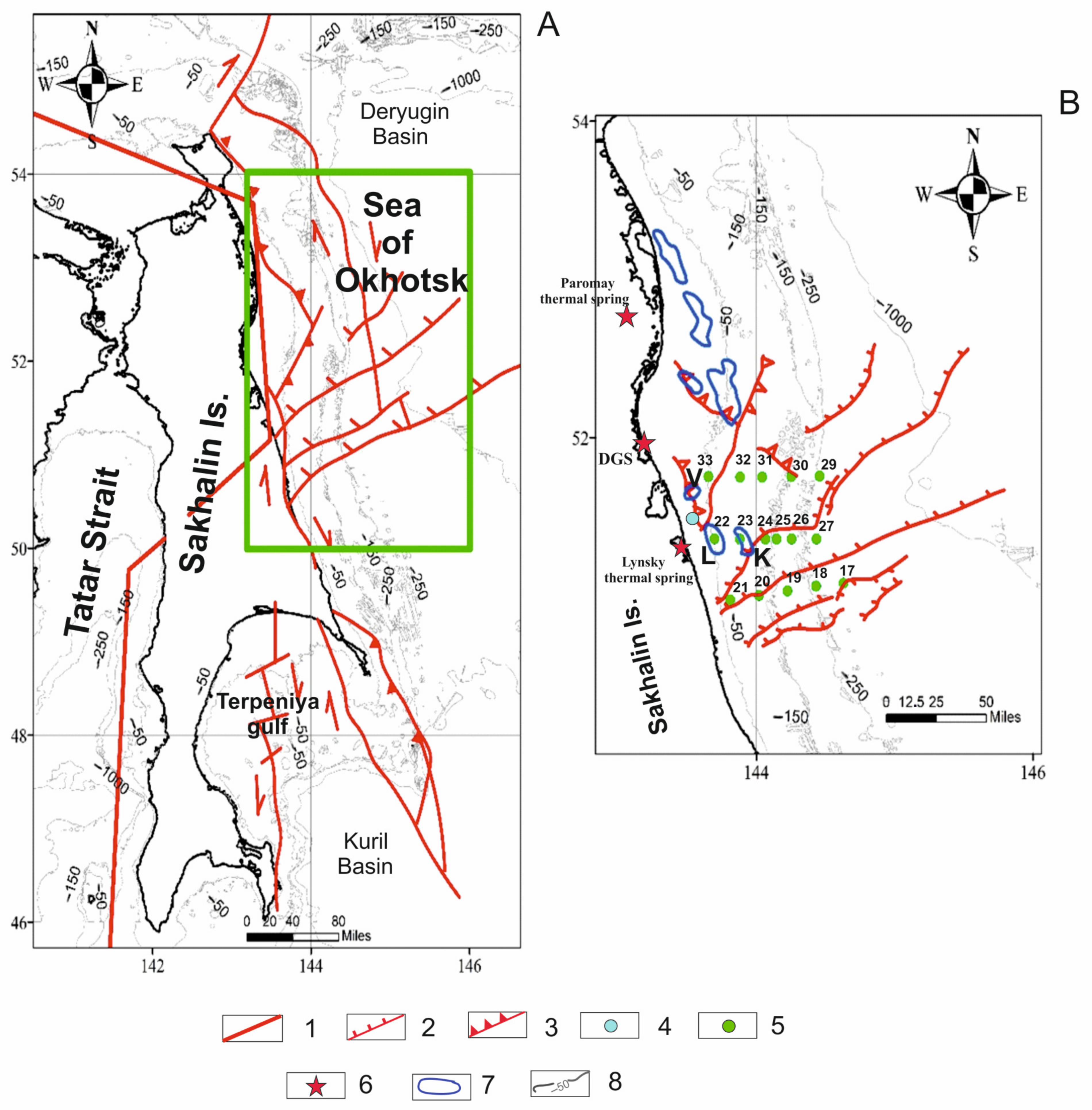
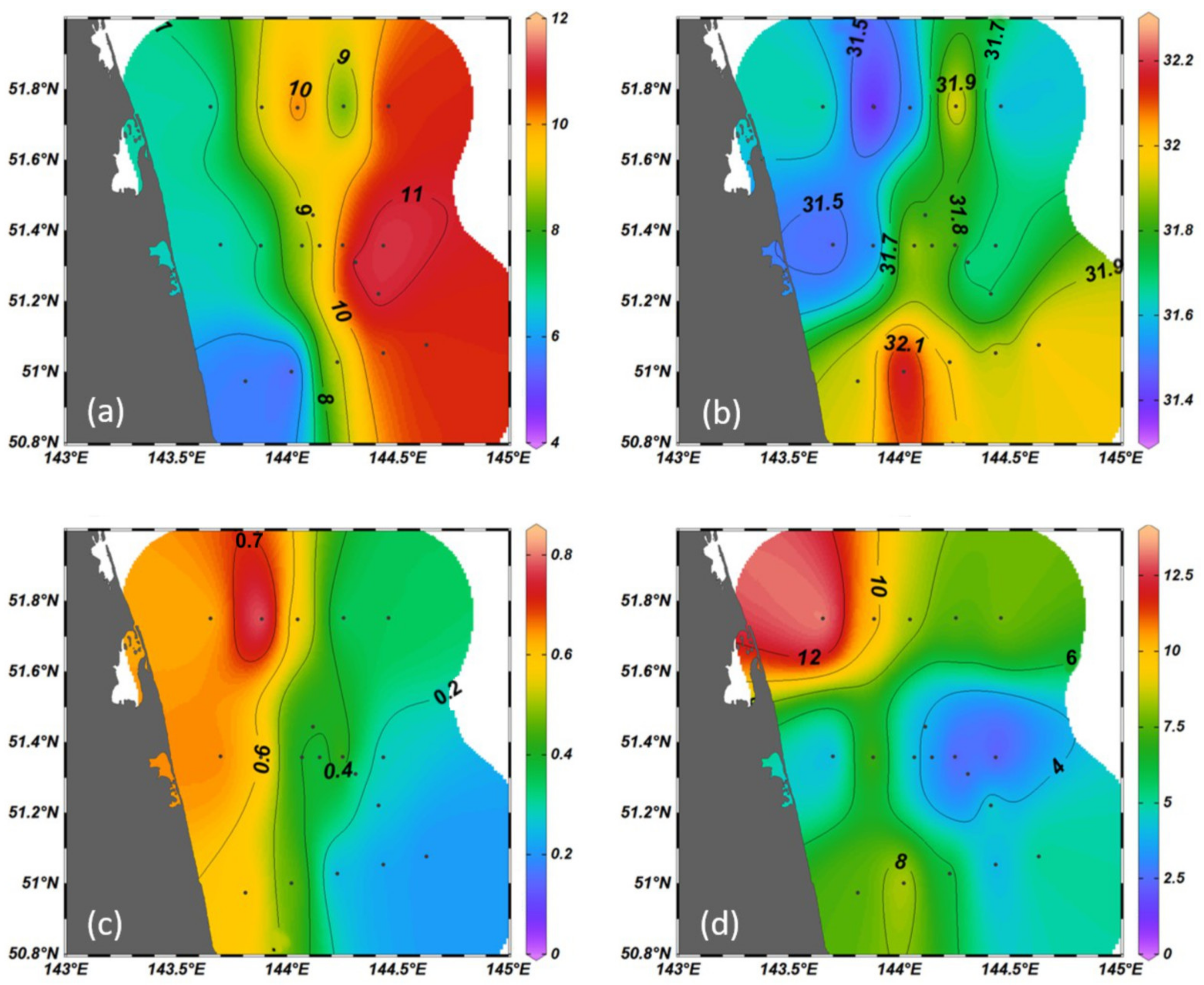

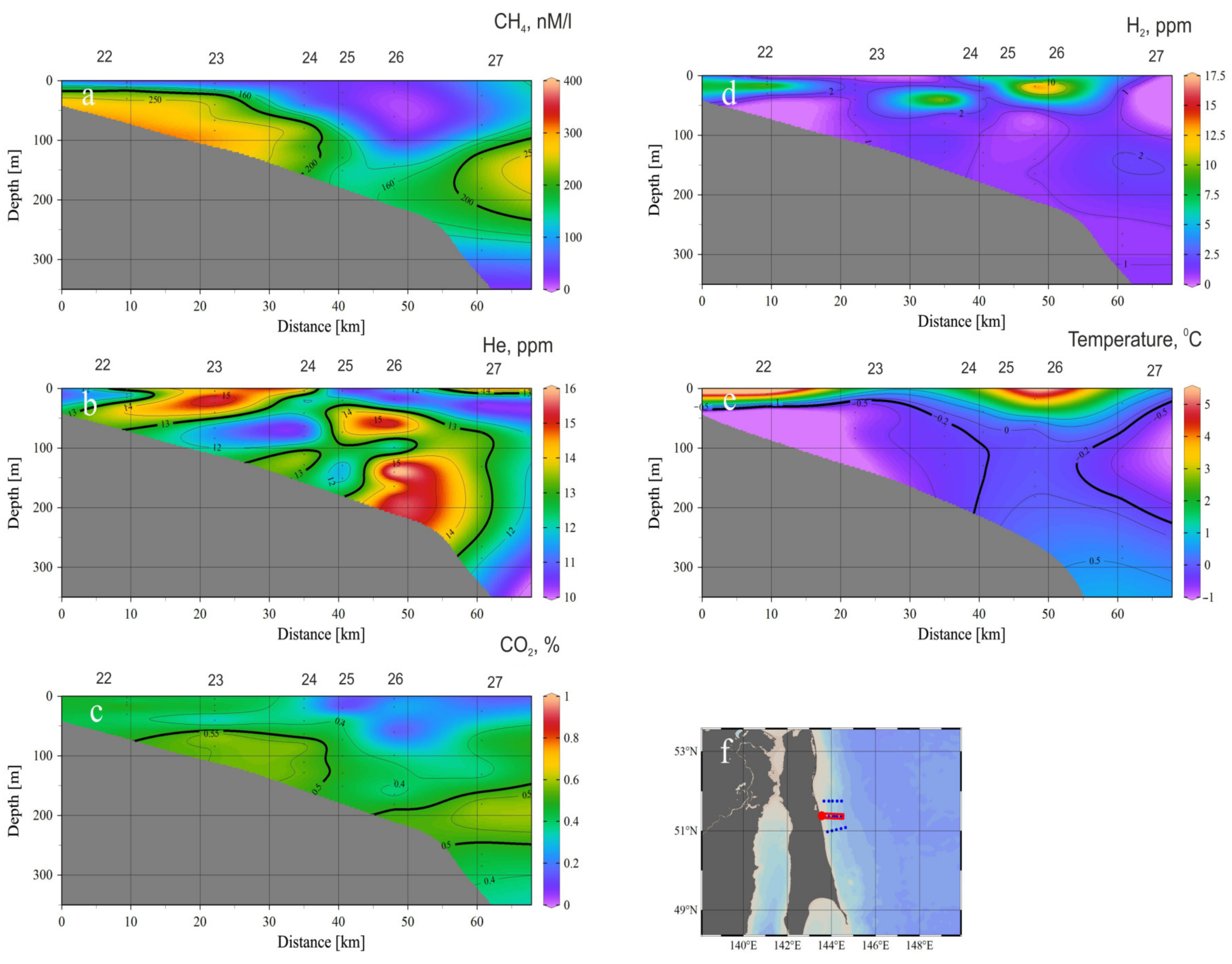

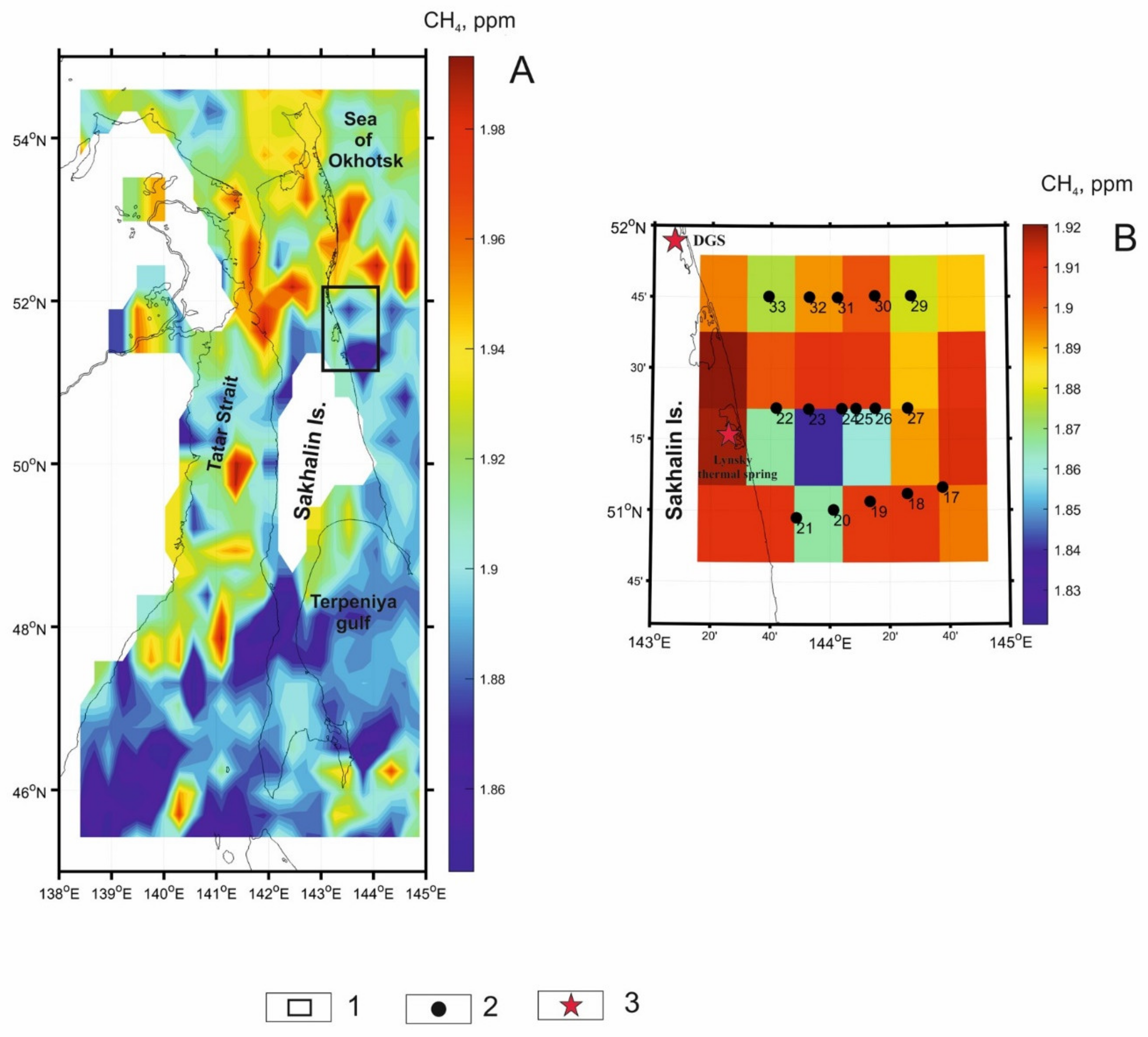
| Station | Depth | |||||||
|---|---|---|---|---|---|---|---|---|
| Section 1 (northern) | 17 | 303 | 281 | 238 | 202 | 72 | 26 | 4 |
| 18 | 225 | 201 | 149 | 79 | 54 | 28 | 4 | |
| 19 | 161 | 134 | 85 | 85 | 62 | 34 | 4 | |
| 20 | 127 | 108 | 75 | 76 | 51 | 30 | 4 | |
| 21 | 67 | 58 | 46 | 45 | 26 | 15 | 4 | |
| Section 2 (central) | 22 | 30 | 15 | 10 | 4 | |||
| 23 | 84 | 66 | 40 | 24 | 15 | 4 | ||
| 24 | 110 | 80 | 63 | 41 | 20 | 4 | ||
| 25 | 151 | 129 | 100 | 73 | 39 | 20 | 4 | |
| 26 | 182 | 164 | 140 | 99 | 60 | 18 | 4 | |
| 27 | 284 | 265 | 181 | 131 | 74 | 25 | 4 | |
| Section 3 (southern) | 29 | 281 | 260 | 200 | 132 | 61 | 30 | 4 |
| 30 | 140 | 121 | 91 | 61 | 30 | 16 | 4 | |
| 31 | 96 | 80 | 61 | 35 | 21 | 11 | ||
| 32 | 76 | 61 | 40 | 29 | 17 | 11 | ||
| 33 | 45 | 39 | 31 | 20 | 10 | 4 | ||
| CH4 | CO2 | He | H2 | |
|---|---|---|---|---|
| Water Samples, pcs | 95 | 95 | 95 | |
| Total | 285 | |||
Disclaimer/Publisher’s Note: The statements, opinions and data contained in all publications are solely those of the individual author(s) and contributor(s) and not of MDPI and/or the editor(s). MDPI and/or the editor(s) disclaim responsibility for any injury to people or property resulting from any ideas, methods, instructions or products referred to in the content. |
© 2024 by the authors. Licensee MDPI, Basel, Switzerland. This article is an open access article distributed under the terms and conditions of the Creative Commons Attribution (CC BY) license (https://creativecommons.org/licenses/by/4.0/).
Share and Cite
Syrbu, N.; Kholmogorov, A.; Stepochkin, I.; Lobanov, V.; Shkorba, S. Formation of Abnormal Gas-Geochemical Fields and Dissolved Gases Transport at the Shallow Northeastern Shelf of Sakhalin Island in Warm Season: Expedition Data and Remote Sensing. Water 2024, 16, 1434. https://doi.org/10.3390/w16101434
Syrbu N, Kholmogorov A, Stepochkin I, Lobanov V, Shkorba S. Formation of Abnormal Gas-Geochemical Fields and Dissolved Gases Transport at the Shallow Northeastern Shelf of Sakhalin Island in Warm Season: Expedition Data and Remote Sensing. Water. 2024; 16(10):1434. https://doi.org/10.3390/w16101434
Chicago/Turabian StyleSyrbu, Nadezhda, Andrey Kholmogorov, Igor Stepochkin, Vyacheslav Lobanov, and Svetlana Shkorba. 2024. "Formation of Abnormal Gas-Geochemical Fields and Dissolved Gases Transport at the Shallow Northeastern Shelf of Sakhalin Island in Warm Season: Expedition Data and Remote Sensing" Water 16, no. 10: 1434. https://doi.org/10.3390/w16101434
APA StyleSyrbu, N., Kholmogorov, A., Stepochkin, I., Lobanov, V., & Shkorba, S. (2024). Formation of Abnormal Gas-Geochemical Fields and Dissolved Gases Transport at the Shallow Northeastern Shelf of Sakhalin Island in Warm Season: Expedition Data and Remote Sensing. Water, 16(10), 1434. https://doi.org/10.3390/w16101434






